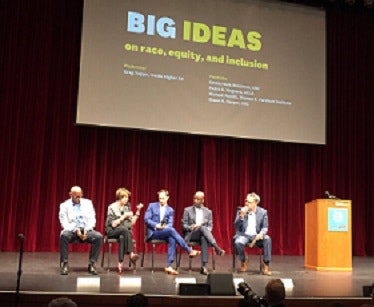LOS ANGELES — Gathered for the 2018 Education Writers Association (EWA) National Seminar, hundreds of education journalists heard from education experts, thought leaders and other fellow journalists about ways to make their coverage of today’s education issues nuanced, culturally relevant and enlightening.
 Opening day panel discussion at Education Writers Association National Seminar in Los Angeles.
Opening day panel discussion at Education Writers Association National Seminar in Los Angeles.The three-day seminar, “Room for All? Diversity in Education and the Media,” kicked off on Wednesday with University of Southern California Race and Equity Center executive director Dr. Shaun R. Harper issuing a call to action for journalists to take seriously their role as truth-tellers to the public.
“I very much would like for education writers to use your role as teachers, to teach the nation about the ways racism continues to contaminate colleges and universities,” he said.
Harper, Provost Professor in Education and Business at USC, listed 10 ideas during the first segment of the session “Big Ideas on Equity, Race and Inclusion in Education,” which focused on issues education journalists were urged to cover in more depth:
1. Racial mismatch between students and educators
2. Educator preparation for racially diverse contexts
3. Racial inequities in school discipline
4. Racialized opportunity tracking within and between schools
5. Policies and protections for undocumented students
6. Erasure of Asian American and Native American students (within the broader Deferred Action for Childhood Arrivals conversation)
7. White nationalists recruiting White students — especially young White men
8. Campus climate, encounters with racism and racist speech
9. Erasure of women of color in sexual assault media coverage
10. Claims of racial discrimination in admissions hiring
Often, the face of a sexually assaulted woman in the press is that of a “young White undergraduate woman,” Harper said, adding that more attention to be paid to the plight of young women of color.
And regarding White claims of racial discrimination in admissions hiring, what may seem like discrimination is intentional action by institutions to create a student body that reflects the populace of the country, he added.
 Dr. Shaun R. Harper
Dr. Shaun R. HarperJournalists should help their audiences understand how Black, Latino, Asian, Native American and Pacific Islander students and educators experience the education system, while also keeping in mind the language used to write about these groups, Harper said.
In a subsequent panel segment about the suggested ideas, Dr. Estela Mara Bensimon, professor of higher education at USC Rossier School of Education and director of the Center for Urban Education said that promoting more coverage on the racial mismatch between students and the teachers, administrators and other education leaders who serve them was important.
Bensimon cited community colleges in California, where her center found that 45 percent of students are Latino yet only 15 percent of faculty are Latino.
“There is no reason for that,” she said, adding that a faculty member needs nothing higher than a master’s degree to teach at many community colleges. “The structure itself functions in a way that continues to reproduce White faculty.”
Bensimon challenged the common argument of a lack of diverse candidates for faculty positions. “The pipeline argument is a myth. People tend to hire people like themselves unless you change the rules of the game.”
Higher education institutions should “change the scripts” of their hiring processes, she said, by examining details such as the placement of job announcements and how schools coordinate on-campus interviews.
Dr. Pedro A. Noguera, Distinguished Professor of Education at the University of California at Los Angeles, highlighted racial segregation in K-12 schools as a relevant and timely issue in education. He also urged education journalists to report on segregation in charter schools, as well as education’s influence on politics.
“Why are billionaires so invested in charter schools, given that they serve a small percentage of the population?” he asked the auditorium full of journalists.
Michael J. Petrilli, president of the Thomas B. Fordham Institute and research fellow at The Hoover Institution at Stanford University, said many educators and others are “sympathetic” to issues plaguing education today.
However, he said, “This is a very difficult time to talk about race,” adding that racism and racial bias sometimes do not “explain the entirety” of an issue.
Whether issues in education stem from students’ experiences with poverty, environmental racism — increased exposure to lead poisoning, for example — or other factors, Petrilli urged journalists to “dive into the full complexity” of the issues.
“We can’t expect simplistic” conceptions of race, Noguera added. “Now we have to unpack it,” and ask what is really going on here, he said.
Responding to a question from the audience, Harper cautioned White journalists against doing just a “drop in” to minority communities when they need a quote or soundbite. They should engage with the communities, he said, building relationships with community members to understand how education and other social issues affect them.
“Have some cultural context that makes its way into the story,” Harper said.
Tiffany Pennamon can be reached at [email protected]. You can follow her on Twitter @tiffanypennamon.





















